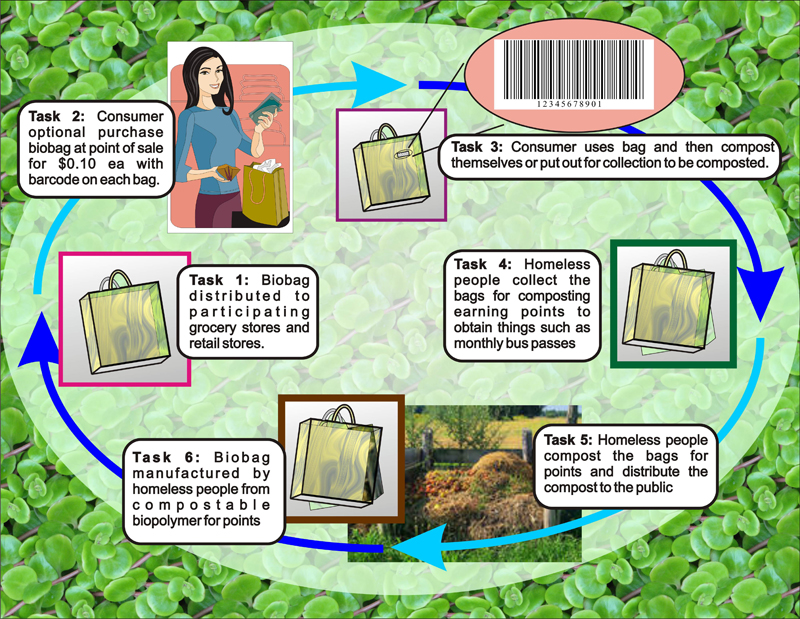 |
|||||||||||||
|
 |
|||||||||||||
|
1. Starting Project: New Title: Paper or Plastic - The Total Opt Out (On Demand, Virtual, Environmentally Friendly Container Cube)
The no mess, non-physical container created from six-sided interwoven electrical and magnetic fields. The resultant fields are so small as to exclude the smallest atoms and subatomic particles.
2. Statement of the Problem
Globally plastic bags, packaging and containers provide consumers with a method for carrying food and goods. Unfortunately more than 90% this mass is discarded and becomes an enormous burden in landfills, waterways, and the oceans of the world.
The Environmental Protection Agency United States 2010 solid waste numbers in Figure 6 (1) details for the "Containers & Packaging" category at 30.3% for Municipal Solid Waste weighing 75.75 million tons. This yearly weight is equivalent to 19 million cars (2 tons) placed end to end the cars (15 ft long) wrapping around the world 9.5 times. This yearly plastic waste ends up in landfills or accumulates in the oceans.
 |
(1) Figure 6. Environmental Protection Agency, (EPA), Municipal Solid Waste Generation, Recycling, and Disposal in the United States: Facts and Figures for 2010, EPA-530-F-11-005, December 2011, www.epa.gov/wastes. |
Marine debris has become a large environmental problem and one of the largest contaminants are plastic and paper bags, caps and lids, and food wrappers and containers. In Table 4 (2) below from the United Nations Environment Programme publication Marine Litter: A Global Challenge, the bag and container portion adds up to 27.4% of marine debris.
 | (2) United Nations Environment Programme, UNEP, 2009. Marine Litter: A Global Challenge. Nairobi: UNEP. 196 pp. |
3. The Biobag Re-Cycle Tasks
Tasks One: Tasks One: Manufacture an eco-friendly biopolymer and natural fiber based compostable bag (biobag) replacement for the existing plastic point of sale bags sold as an option at grocery stores and shops. Homeless people distribute the bags to participating stores and vendors.
Tasks Two: Put a barcode on the bag coded for a retail sale price of $0.10 that the consumer opts to pay for the biobag. The $0.10 from each bio bag sale goes into a fund to support the manufacture of the biobags and support the other steps in the re-cycle.
Task Three: The consumer does one of three things with the bag after the first use ideally:
Task Four: The homeless collect the bags and take them to the city compost station for points usable to buy a monthly bus pass, get food and shelter.
Task Five: The homeless compost the bags and distribute the compost to the public for points at the city recycle station.
Task Six: The homeless manufacture the bags from cornstarch.

4. The Four-Part Process
We have introduced Polya's (How to Solve It) method for solving problems. Let's review how we have applied the method here:
Step 1. Understanding the Problem
What is the unknown? What types of biopolymers would be easy to make and yet compost quickly in a case where the bag was left in the environment outside of a compost pile.
What is the condition? The current plastic bag condition has no real recycling (less than 8% in the United states) and the plastic bags do not break down for hundreds of years.
What is known? The grocery plastic bag is extremely pervasive and replacing the bag in all markets may be difficult from a logistics standpoint and the replacement with a different bag may not have the best acceptance in various societies.
Step 2. Devising a Plan
Do you know a related problem? The problem of a non-reusable cheap plastic bag used worldwide is the largest problem and the solution may have been mandated by city of San Francisco to eliminate the sale of anything but approved biologically compostable bags.
Look at the unknown. The city passed the cost over to the shop keeper and derived the cost from fine levied for violations of the recycling mandates.
Here is a problem related to sours and solved before. Could you use it? Only a few of the aspects from their program can be applied. Much of the research performed on recyclable plastics and composting are readily available.
Could you restate the problem? The non-compostable ubiquitous plastic point of sale bag has become a large pollutant in the world and must be replaced quickly before the effects become irreversible to the ecosystems of the earth.
Step 3. Carrying Out the Plan
Carry out the plan. Creating biopolymers made with cornstarch for the creation of bag prototype.
Check each step Carefully considering the best solution for a usable bag with a compostable biopolymer.
Step 4. Looking Back
Can you check the result? This is a new program and there are no results.
Can you use the result, or the method, for some other problem? Potentially the process can be used in other areas of the country where a large population of homeless people would be interested in the work. The same areas of the country would likely have a problem with the non-compostable plastic bag.
5. Future Work
A. Expand the program to other cities and areas particularly where homeless people would benefit from having an option to own a program for points to receive goods and services from their own efforts.
6. Links to Website for Biopolymers and Composting
A. Green Plastics - a good comprehensive site with practical recipes and very information videos on how to make biopolymers.
B. Bioplastic bag - a great video showing how to make biopolymer with cornstarch.
C. Natureworks - website that shows all the different commercial bioplastics of one supplier
D. Biodeg.net - comprehensive technical website showing that many "compostable" biopolymers are actually a problem if not put in a heated bioreactor with breakdown bacteria.
Prototype

Sarah Kintner with prototype biodegradable plastic bag, made from sage.
| Making of a Prototype | |
| Sarah Kintner makes a prototype biodegradable plastic bag. | |